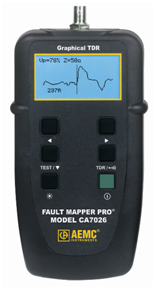What is a TDR?
 A TDR (Time Domain Reflectometer) is used for cable length measurement and fault locating on virtually all types of cable including twisted pair, coaxial and parallel conductors. Access to two conductors from one end is required.
A TDR (Time Domain Reflectometer) is used for cable length measurement and fault locating on virtually all types of cable including twisted pair, coaxial and parallel conductors. Access to two conductors from one end is required.
The TDR transmits pulses of a known shape and amplitude into one end of a cable at a speed determined by its Velocity of Propagation. Vp is a ratio of the speed of light.
As the pulses reach impedance changes in the insulation of the cable, indicative of a fault or cable end, reflections are caused that travel back along the cable and are identified by the TDR.
The size, shape and general nature of the reflected pulses indicate the type of fault encountered, and the time taken for the pulse to be reflected enables an accurate measurement of distance to the fault to be determined.
Why use a TDR?
Continuity and performance of service of modern communications systems is of paramount importance, and all new installations and modifications to existing installations must be tested to ensure trouble free operation. Additionally, in the case of a fault in the cable infrastructure, it is necessary to identify, locate and rectify the situation in as little time as possible, ensuring rapid return of the service.
Applications
Electrical, communication and telecommunication engineers and contractors for testing cable installations as part of a routine preventative maintenance program. In addition, during, or after work on, all new cable installations and modifications to existing cable installations, tests can be made to ensure performance criteria are met.
Personnel involved in the location of cable faults as part of a responsive or routine maintenance program.
Electrical Inspectors performing quality checks following work on all new cable installations, and modifications to existing cable installations.
Source: AEMC
